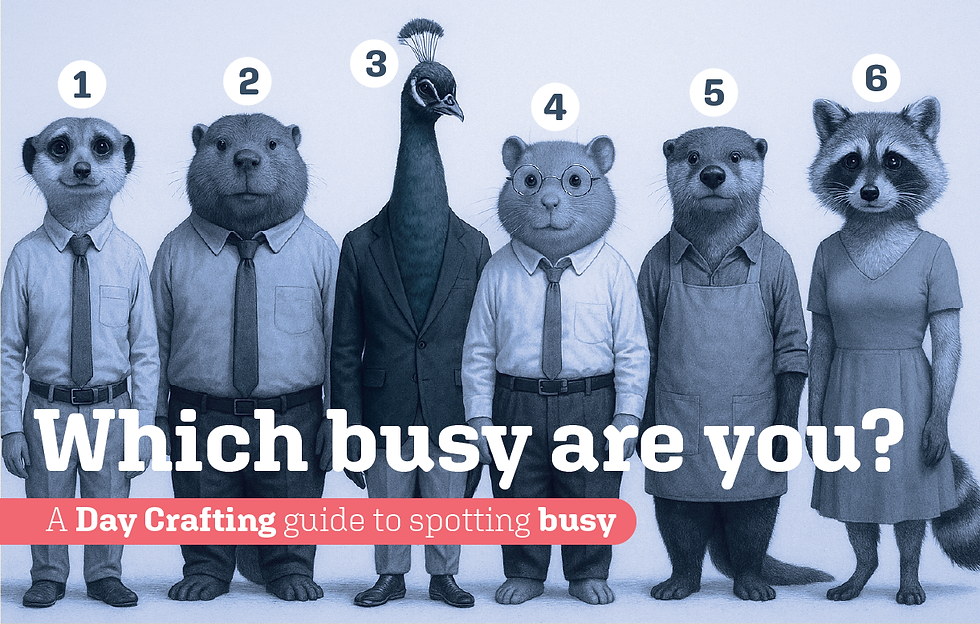10 Proactive Diary Tools to Escape Reactive Workdays
- Bruce Stanley

- Mar 23, 2024
- 3 min read
The Secret to Better Workdays? Get to your Diary First First
Does your work system feel more like A or B?
A | B |
|
|
A) are all hallmarks of a reactive working system: tasks are urgent, we’re in demand, thinking has to be fast and habitual, and we’re somewhat satisfied if our output is good enough – all the stuff of reactive workdays. B) are more typical of a reflective system: less pressured, tasks are important, but we can be slower and more deliberate to enable higher-quality output.

From Reactive Workdays into Reflective Productivity Blocks
You may find the following idea helpful if you’re on a journey to switch your productivity system from reactive workdays to reflective ones. The blank days in your future diary will, by default, become reactive days if you have no rules, purpose, or Filter through which to shape your blueprints. But how do you proactively make the days, weeks, or months from now more reflective? Try owning the process and getting to those blank time blocks first with some of the following elements:
Reflective Diary Elements
Buffer Time
Brain Dump
Loop Closing
New Strengths Use
Active Rest
Side/Delight Project
Wiki-Wormhole
Service
Gratitude/Celebration
Purpose Refining
Buffer Time: Scheduled intervals between tasks or appointments that give you flexibility and downtime. These periods can be used to manage unexpected demands and transition between activities, or you can block out days or half days that you don’t schedule anything for until the day before.
Brain Dump: A technique to clear your mind by transferring ideas onto paper or a digital tool. This practice can help reduce mental clutter, improve focus, and facilitate better planning and prioritisation by making thoughts and tasks more tangible and manageable.
Loop Closing: Similar to the brain dump, loop closing is a mindful and reflective activity to capture worries, concerns, and to-dos. It’s also important to recognise that you can capture half-formed anxieties. Just listening to yourself in this way can make the difference between being able to focus or not. You can also use loop closing to practically finish a load of little tasks.
Signature Strength, Novel Use: Identifying and applying your core personal strengths in new and diverse ways. This practice encourages creativity and personal growth by finding unique applications for your innate talents and abilities, enhancing satisfaction and effectiveness in both personal and professional contexts.
Active Rest: Engaging in restful yet mentally or physically stimulating activities, as opposed to passive relaxation. Examples include walking in nature, practising hobbies, or gentle exercise. Active rest rejuvenates the mind and body, promoting wellbeing and maintaining energy levels for prolonged productivity.
Side Project / Delight Project: A personal project pursued out of interest or passion rather than obligation. Whether it’s a creative endeavour, learning a new skill, or volunteering, these projects provide a sense of fulfilment and joy, as well as an outlet for creativity and personal expression.
Wiki-Wormhole: The act of exploring information or learning new facts through online platforms, such as Wikipedia, in a nonlinear or serendipitous manner. This activity stimulates curiosity and can expand knowledge on various topics, although it requires discipline to manage the time spent on exploration.
Service: Activities or work performed for the benefit of others without expectation of reward or recognition. Service can involve volunteering, helping neighbours, or any act of kindness. Engaging in service fosters a sense of connection, community, and personal fulfilment through contributing to the greater good.
Gratitude / Celebration: The practice of acknowledging and appreciating the positive aspects of life and celebrating achievements and milestones, big or small. This can be done through journaling, sharing with others, or reflective meditation. Fostering gratitude and celebrating successes enhances wellbeing, reinforces positive relationships, and promotes a positive outlook on life.
Purpose Refining: The continual process of reflecting on your values, goals, and passions to clarify and adjust your sense of purpose and direction. This can involve setting aside time for self-reflection, seeking new experiences, and adjusting goals to align with evolving insights and aspirations. Purpose refining helps maintain motivation, direction, and a sense of meaning in life.
The Practice
Copy or make a note of the 10 reflective diary elements and keep it handy. Make time once a week to design your future days to be balanced and as reflective as you want them to be.









Comments